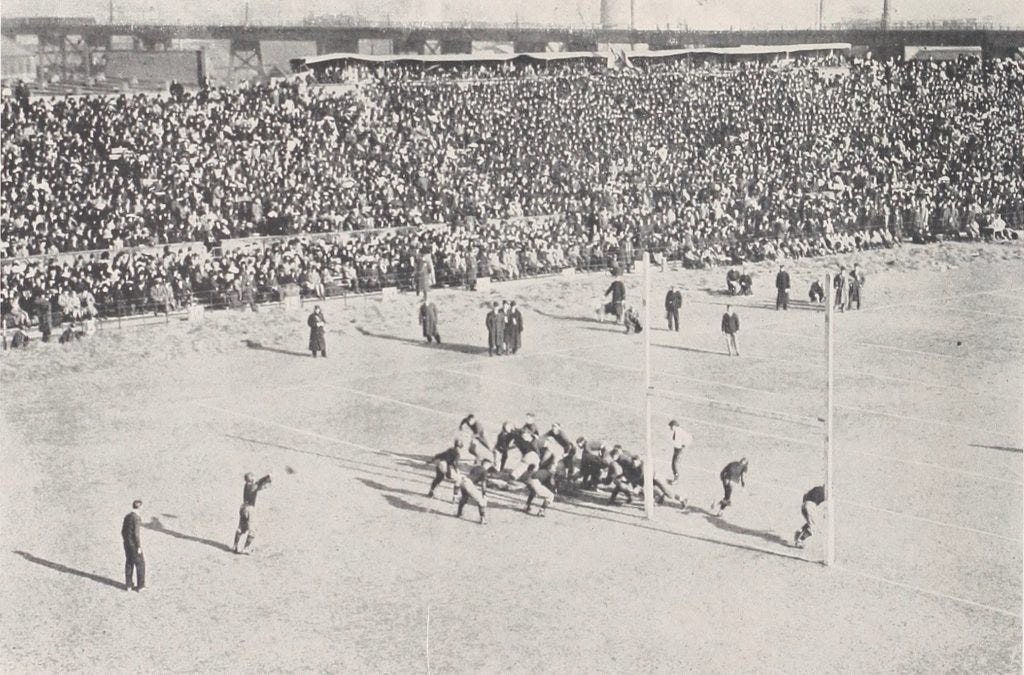Football Before End Zones
Many elements of modern football were not part of the early game. One such feature was the end zone. As strange as it may seem, end zones were not marked on football fields for more than forty years of play, entering the game in 1912 as the rule-makers loosened restrictions on the forward pass.
To understand how football could operate without end zones requires looking at differences in the game and rules between then and now. From 1882 through the 1902 season, the football field had sidelines (known as "touch lines" at the time), goal lines, and yard lines spaced every five yards between the goal lines and the 55-yard line. Some fields extended the sideline for ten yards beyond the goal line, but none had end lines since they did not need them. Touchdowns could only be scored by carrying the ball across the goal line and into the "in goal" area. With the forward pass being illegal, there was no need to mark the areas beyond the goal lines.

An attempt to open up the game in 1903 allowed the first person receiving the snap to run the ball upfield as long as they were five or more yards to the right or left of the center. (Previously, the ball had to be possessed by a teammate before the ball could be run upfield.) The 1903 checkerboard applied only between the 25-yard lines and did not change the fact that the field did not have an end zone.

The 1903 rule requiring the field to be marked with the checkerboard only between the 25-yard lines changed in 1904 when the five yards left or right of center rule was applied to the entire field.

After legalizing the forward pass in 1906, the game still did not need an end zone because forward passes that crossed the goal line on the fly or on a bounce resulted in a turnover. An offensive player could carry forward passes caught in the field of play across the goal line.
The lack of end zones and end lines had several consequences throughout the period. First, the unmarked end zone allowed some stadiums to accommodate the 110-yard long marked field. It was a tight squeeze in some stadiums, with limited space between the goal line and the grandstands or bleachers.

Another impact occurred when punting from the end zone. We have all seen punters with their heels close to the end line, waiting for the snap, knowing they need to get the punt off quickly. Punters before 1912 also worried about blocked punts, but they could stand as far behind the center as they desired to reduce the likelihood of a punt block.
The checkerboard disappeared in 1910 and the end zone came into being when football adopted a series of safety-related rule changes in 1912, most geared toward opening up the game. One such rule allowed forward passes to be caught behind the goal line. (Incomplete passes that entered the end zone continued to result in the loss of possession.) Without adding end lines, there would have been nothing to stop teams from throwing and catching balls thirty or forty yards behind the goal line, so the rule makers added end lines ten yards deep, and they named the enclosed areas the End Zones.
On the other hand, adding 10-yard deep end zones at either end of the field meant the marked field would be 130-yards long, which did not fit in some key stadiums of the time. To make the field fit, the rule-makers eliminated the 55-yard line from the American football field, making the playing field 100 yards long and the marked field 120 yards long. The kickoff shifted from midfield to the kicking team's 40-yard line at that time as well.
Canada, which adopted the 110-yard field with 25-yard deep end zones, properly called "goal areas," in 1892, never eliminated the 55-yard line, though they shortened their end zones by five yards in the 1990s.
Football Archaeology is reader-supported. Click here to buy one of my books or otherwise support the site.


